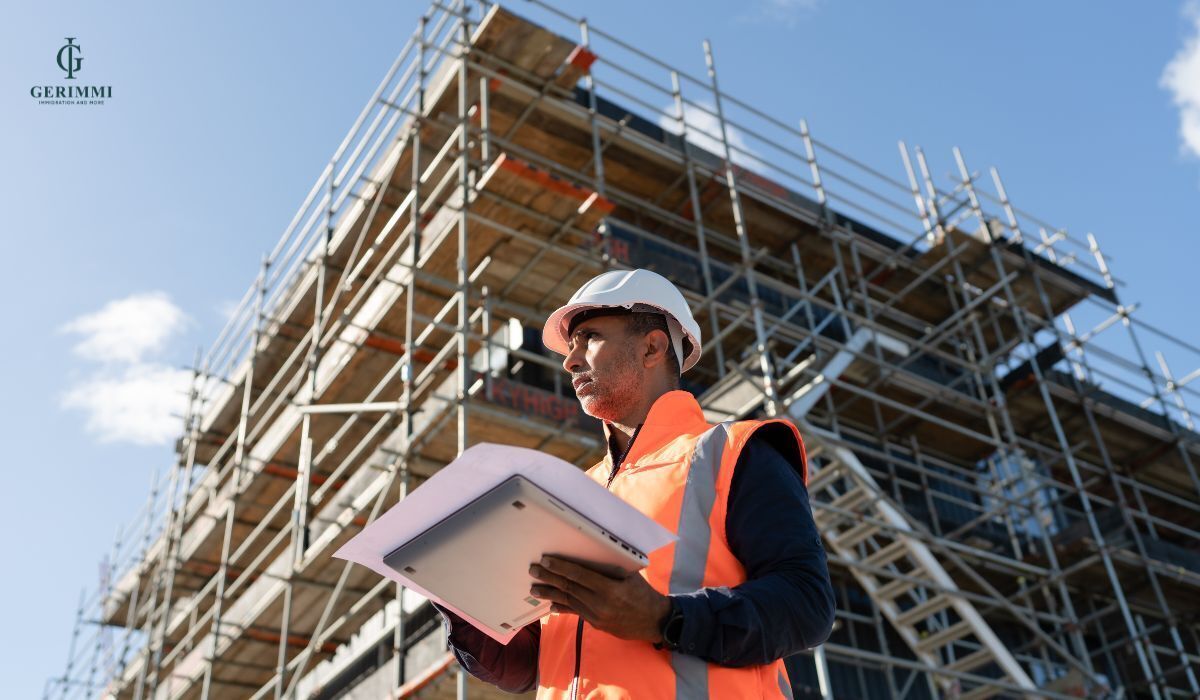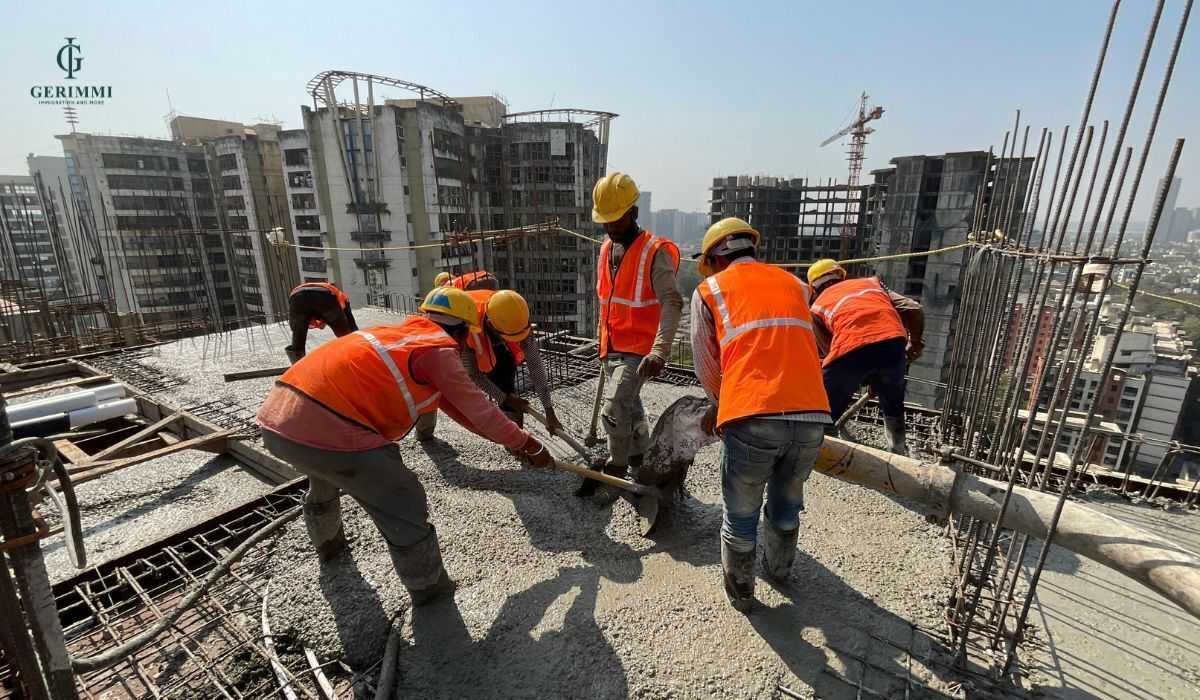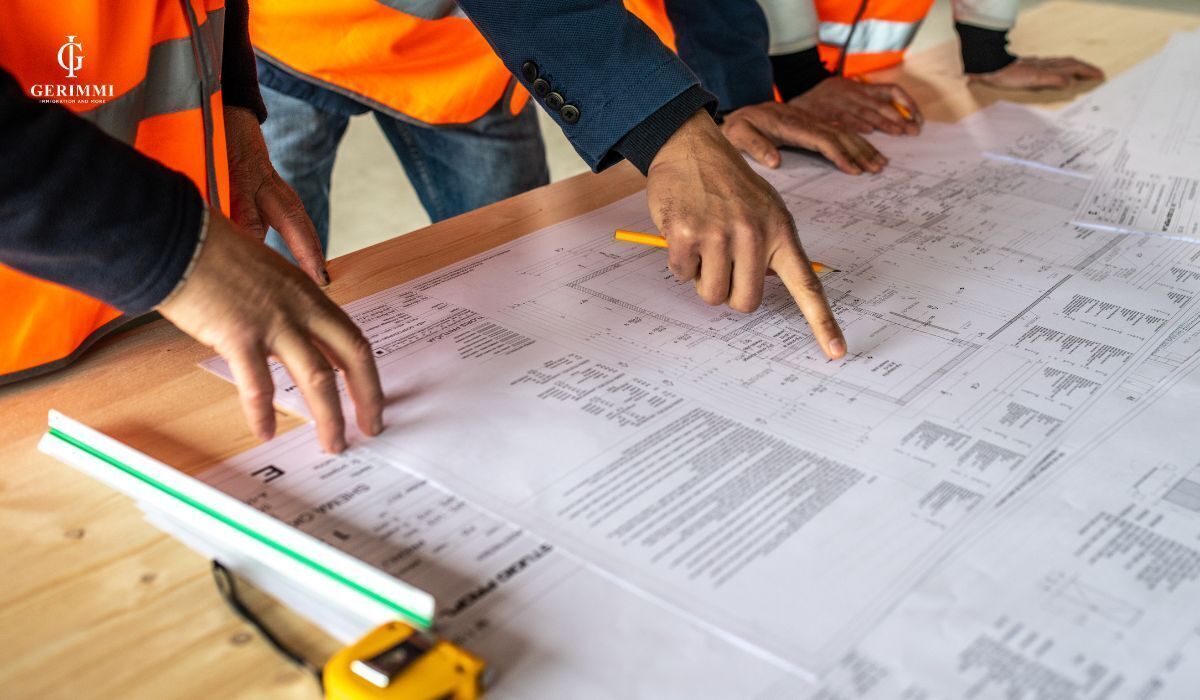Studying construction in Australia is a great choice for those who want to learn quickly, at low cost and have a high chance of settling down. With the VET practical program, the scarce occupations of Skilled Migration Construction Australia, students can easily find jobs, have a clear path to apply for PR and develop a long-term career in Australia.
I. Why should you choose to study construction in Australia?
Australia is currently one of the countries with the highest demand for construction trades workers in the world. According to forecasts, this industry needs more than 500,000 more workers by 2029, especially in the occupations of Carpenter, Bricklayer, Electrician, Plumber - all of which are on the Medium and Long-Term Strategic Skills List (MLTSSL).
- Vocational Training Construction Australia (VET)
The VET program focuses on practical skills in workshops and construction sites. Students learn safety procedures, operate machinery, and understand international occupational standards. This is an advantage to help them quickly integrate into the labor market.
- Low cost, short time
Tuition fees for Certificate III/IV or Diploma of Building and Construction are around AUD 8,000 - 15,000/year. Training time is 1.5 - 2 years, much shorter than university level, helping you to have skills and start working soon.
- Fast Track Migration (Skilled Migration Construction Australia)
After graduation, students can apply for a 485 visa to stay and work. This experience supports the application for TRA Skills Assessment, a prerequisite for Skilled Migration. This is a popular route to fast-track settlement for skilled construction workers.
- Priority consideration for construction apprenticeships in Australia
Carpenter, Bricklayer, Plumber, Electrician are on the MLTSSL list. The Australian Government prioritizes applications for this group of occupations, creating a high chance of receiving PR (Permanent Residency).

II. Popular and prioritized vocational programs for settlement
1. Certificate III/IV in Carpentry
Construction carpentry training course, including construction skills, installation, repair and maintenance of wooden items. Students learn directly on-site practice, combining theory on drawings and safety standards.
- Belong to the listMLTSSL (Medium and Long-Term Strategic Skills List).
- ProfessionCarpenteralways in the shortage group in Australia.
- Job opportunities andSkilled Migration Construction Australia very high
2. Certificate III in Wall and Floor Tiling
Wall and floor tiling apprenticeship program. Students learn how to cut, fit, lay tiles, use waterproofing materials, and comply with building regulations.
- Human resource needsMajor shortages in Victoria and New South Wales.
- Tiler is one of the professions that makes it easy to get a job right after graduation.
- Opportunity to participate in fast track settlement in states with skill shortages
3. Certificate III in Plumbing
Plumbing course, focusing on water supply and drainage systems, installation, equipment maintenance and occupational safety.
- ProfessionPlumberhigh income, high demand in both cities and suburbs.
- Belongs to a scarce skilled industry, easy to apply for work and settlement visas.
- Graduates are recognized inTRA Skills Assessment to apply for Skilled Migration.
4. Certificate III in Bricklaying and Blocklaying
Training program for bricklayers, stone masons, load-bearing walls and basic construction structures.
- Located inSkilled Occupation List and are given priority for settlement.
- Wide open job opportunities at large construction sites and housing projects.
- Especially suitable for students who want to followSkilled Migration Construction Australia.
5. Diploma of Building and Construction
Advanced level course focusing on construction management and supervision. Students learn about project management, blueprint reading, construction supervision and manpower coordination.
- Suitable for those who want to develop into a position site supervisor, project manager.
- Good settlement opportunity because it meets the demand for high quality human resources in the construction industry.
- As a stepping stone to move forward permanent settlement and career development in Australia.

III. Vocational visa & fast settlement path
When choosing construction vocational study in Australia, visa is the key factor that determines the path of study, work and settlement. Especially for the group of industries belonging to construction apprenticeship AustraliaThe Australian government always creates favorable conditions for international students to gain experience, improve their skills and gradually move towards permanent residency (PR).
1. Visa 407 Training Visa Australia
The 407 visa is the first door for students who want to participate in vocational training and internship programs in Australia. This visa allows you to participate in practical training courses in the construction industry, working directly under the guidance of a sponsoring business or organization.
The visa is usually valid for a maximum of 2 years, enough for students to gain practical experience and become familiar with the local working environment. However, to be granted a 407 visa, students need to have an Australian business agree to sponsor them. This is the factor that makes the 407 visa an important stepping stone, because this internship experience will make the skilled migration application more solid.
2. Visa 485 Temporary Graduate Visa
After completing a vocational course such as Certificate III, Certificate IV or Diploma of Building and Construction, students can apply for a 485 visa to continue to stay and work legally in Australia. The visa duration ranges from 18 to 24 months, depending on the field of study and training area.
During this period, students can find work in the construction industry, accumulate income as well as demonstrate professional skills. Importantly, the experience from the 485 visa is the foundation for you to participate.TRA Skills Assessment, an indispensable step if you want to go under the programSkilled Migration Construction Australia.

3. Skilled Migration Visa
This is the ultimate goal of many international students in the construction industry, as the skilled visa group not only allows long-term work but also opens up the opportunity for settlement. There are three common types of visas:
- Subclass 189 Skilled Independent Visa
DThis is an independent settlement visa, which does not require sponsorship from a state or business. However, to be granted this visa, applicants need to achieve a high EOI (Expression of Interest) score, along with the resultsTRA Skills Assessment recognized. This is the right path for those with outstanding abilities, solid professional skills and good English.
- Subclass 190 Skilled Nominated Visa (State Sponsorship)
This visa requires sponsorship from an Australian state or territory. In return, the applicant must commit to living and working in the sponsoring state for at least 2 years. With the construction industry experiencing a labor shortage in many states such as Victoria, New South Wales or Queensland, the 190 visa is a safer and more accessible option than the 189.
- Subclass 491 – Skilled Work Regional Visa
LThis visa is for people who accept to study and work in a regional area. The visa is valid for 5 years, and if you meet the income and residence requirements (usually 3 years), you can apply for aPR (Permanent Residency).
What all three types of visas have in common is that they all requireTRA Skills Assessment- Skill certification from an Australian occupational assessment agency, along with a standard EOI score. Therefore, right from the beginning of studying construction, students need to clearly define their path to ensure they accumulate enough skills, experience and valid documents.

IV. Skills Assessment is prioritized
To apply for a skilled visa to settle in Australia, applicants are required to go throughSkills Assessment. For the construction industry, the agency directly in charge isTRA - Trades Recognition Australia. This process can be divided into four main points:
- Qualification and work experience assessment
TRA will check the details of the vocational qualifications (Certificate, Diploma) as well as the candidate's learning process and work experience. Completion of courses is recognized asCertificate III in Carpentry, Certificate III in PlumbinggoodDiploma of Building and Constructionwill help your application to be easily qualified, as these programs are already within the national training framework (AQF).
- Practical and interview skills assessment
In addition to the paperwork, TRA often requires candidates to take a skills test or professional interview. This is to ensure that your skills meet Australian quality and safety standards. For occupations such as carpenter, tiler, bricklayer, plumber, this practical part is especially important.
- Priority for occupations in MLTSSL
Many occupations in the construction industry fall withinMLTSSL (Medium and Long-Term Strategic Skills List), which is the long-term skills shortage list in Australia. When your occupation is on this list, your Skills Assessment application will be prioritized for faster processing and the chance of success when applying for a 189, 190, 491 visa will also be higher.
- Stepping stone to apply for skilled immigration visa
Skills Assessment is the "passport" before submittingEOI (Expression of Interest)and apply for Skilled Migration visas. Without this certification, visa applications will not be considered. Therefore, from the time they are studying in Australia, students need to orient themselves early to ensure they are eligible to participate in the assessment, thereby opening up a path to permanent settlement.
-duoc-uu-tien.jpg)
V. State Priorities & Employment Opportunities
When studying construction in Australia, in addition to the general visa policy, each state and territory also has its own policies to attract human resources. This is an extremely important factor on the settlement path. It can be summarized into 4 main points:
- Labor shortage in major states
Populous states likeVictoria, New South Wales and QueenslandThere is a serious shortage of construction workers, especially carpenters, plumbers, tilers and bricklayers. Therefore, construction graduates can easily find jobs and have many opportunities to apply for state sponsorship under the 190 or 491 visa.
- Regional priority policy
The Australian Government encourages skilled workers to work in regional areas (less populated, suburban areas). Applications submitted in these areas often receive additional EOI points, are processed faster, and are more likely to be granted a permanent visa. This is a good strategy for those who want to increase their chances of staying long term.
- Wide open job opportunities, attractive income
The construction industry in Australia offers competitive salaries. For example, a new carpenter can earn between AUD 60,000 and AUD 80,000 per year, while supervisory and project management positions can earn over AUD 100,000 per year. This is a great incentive for students to study and work in Australia.
- Support from state government and local businesses
Some states have special support policies, such as job search assistance, business connections, or facilitating student completion of the process.apprenticeshipThis is an advantage that helps students quickly integrate into the labor market and meet settlement conditions.

VI. Market reality, opportunities & settlement trends
The Australian construction industry is in a period of strong growth, leading to a stable and long-term demand for human resources. Based on reality, it can be summarized into 4 main ideas:
- Rapid population growth, huge infrastructure needs
With a population expected to exceed 30 million in the next decade, Australia needs a series of projects to build housing, schools, hospitals and transport infrastructure. This ensures that the demand for construction workers is always high, opening up many job opportunities for international students.
- Infrastructure investment after the pandemic
The Australian Government is accelerating investment in infrastructure to help the economy recover and grow. The construction industry is therefore the “backbone” of this process, leading to a large demand for skilled workers for many years to come.
- The trend of prioritizing settlement for highly skilled workers
Skilled Migration visas (189, 190, 491) all focus on occupations in short supply on the list.MLTSSL, including many jobs in the construction sector. This shows that the Australian government will continue to prioritize this group of workers on the settlement journey.
- Smart strategy: apprenticeship + regional work
A clear trend is that many international students choose to study construction, then work in regional areas to gain additional EOI points and enjoy preferential policies. This is a "short and sure" path to quickly achieve permanent residency (PR) and develop a long-term career.

Conclusion
Studying construction in Australia not only brings practical skills and a stable income, but also opens up a path to sustainable settlement. If you are looking for a short, sure and opportunistic path, the construction industry is the right choice to start your journey in the land of kangaroos.

